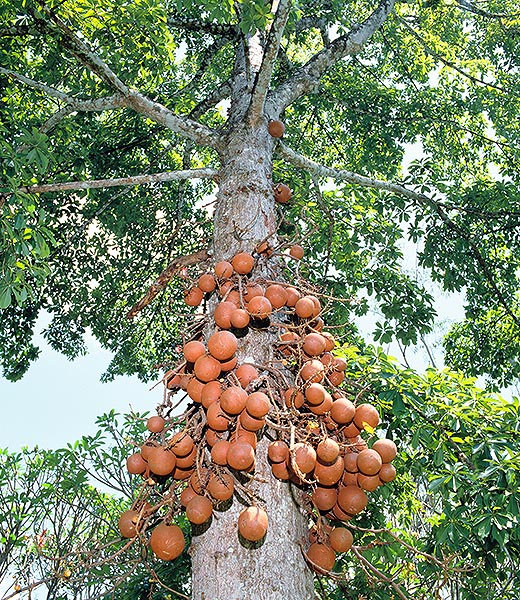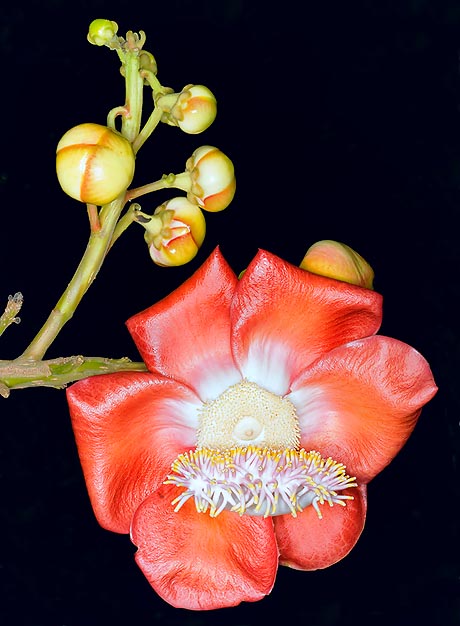Family : Lecythidaceae

Text © Pietro Puccio

English translation by Mario Beltramini

The cannon-ball tree (Couroupita guianensis) may be 30 m tall © Giuseppe Mazza
The name of the genus is the native one of the French Guyana, “couroupitoutoumou”.
The name of the species refers to its origin country.
Common names: cannonball-tree (English); abricot sauvage, arbre à bombres, arbre à boulet de canon (French); abricó-de-macaco, abricoteiro-de-macaco, amêndoa-dos-Andes, castanha de macaco, curupita, macacarecuia (Portuguese – Brazil); bala de cañón, bola de cañón, coco de mono, granadillo de las huaca, mamey hediondo, maraco, muco, palo de paraíso, palo santo, taparo de monte (Spanish); Kanonenkugelbaum (German)
The Couroupita guianensis Aubl. (1775) is an evergreen or semi-evergreen (it may lose the leaves several times during the year, but they are replaced in a few days), tree, which may be 30 m tall, with a cylindrical trunk which can exceed the 70 cm of diameter, and a brownish grey bark slightly fissured lengthwise.
The leaves, grouped at the tip of the branches, are alternate, ovate or lanceolate, with entire or slightly toothed margin, 10-20 cm long and 4-10 cm broad, are of an intense green colour.
The flowers, strongly perfumed, of 8-12 cm of diameter, produced most of the year, are carried by woody, up to 2 m long, racemes, which generate on the trunk (cauliflory) or at the base of the main branches.
The corolla is formed by six fleshy, concave, roundish, petals, two of which are larger, of a colour going from orange to pink, internally red, often yellowish outside, with a white central disc, and several stamina divided in two groups, one fertile around the pistil, and one of sterile stamina, about 2 cm long, united in a sort of a hood over the pistil.

The perfumed flowers are pollinated by the big tropical bats © Giuseppe Mazza
The pulp is edible and at times is locally consumed, but the odour discourages its alimentary utilization, but for the animals. It reproduces by seed which is to be planted when still fresh as it has a short germination time, or by suckers.
It is one of the oddest and most ornamental trees, the trunk of the adult specimens may be covered by flowers and fruits, present at the same time. The flowers last just one day, but are produced in sequence and in great quantity.
It is a tropical and marginally humid tropical climate species, it may bear exceptional drops in temperature down to even -1 °C for a quite short time.
Although it lives in nature on soils almost permanently humid, at times flooded, it adapts also to markedly seasonal climates as it can stand periods of dryness.
It is utilized, mainly as botanic curiosity, in parks and vast gardens with the cleverness of avoiding frequented sites due to the dangerousness of the heavy fruits which may fall down at any time.
All parts of the plant are utilized in the traditional medicine. The outer woody shell (exocarp) of the fruit is locally utilized as container, the upper part of the fruit comes off easily like a cover, and as ornament.
The tree, besides being sacred for the Amazonian natives, as become so also sacred by the Hindus and is planted in the temples dedicated to Shiva in India.
Synonyms: Lecythis bracteata Willd (1799); Pekea couroupita Juss. ex DC. (1828); Couroupita surinamensis Mart. ex Berg (1858); Couroupita peruviana O.Berg (1862); Couroupita antillana Miers (1874); Couroupita membranacea Miers (1874); Couroupita froesii R.Knuth (1934); Couroupita saintcroixiana R.Knuth (1934); Couroupita venezuelensis R.Knuth (1934); Couroupita acreensis R.Knuth (1939); Couroupita idolica Dwyer (1965); Couratari pedicellaris Rizzini (1976).
→ To appreciate the biodiversity within LECYTHIDACEAE family please click here.
